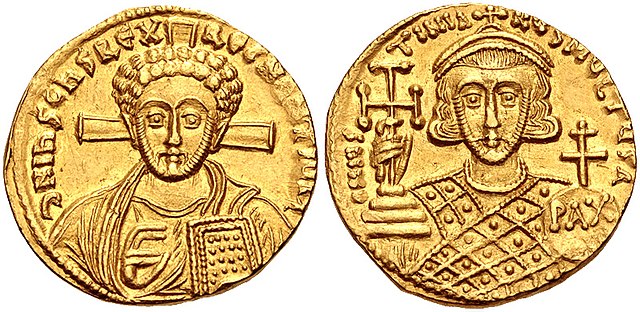Byzantine currency, money used in the Eastern Roman Empire after the fall of the West, consisted of mainly two types of coins: gold solidi and hyperpyra and a variety of clearly valued bronze coins. By the 15th century, the currency was issued only in debased silver stavrata and minor copper coins with no gold issue.
Solidus minted during the second reign of Justinian II (705–711)
Anastasius 40 nummi (M) and 5 nummi (E)
Justinian I half-follis, 20 nummi. Note the K on the reverse.
Romanus III miliaresion.
The solidus or nomisma was a highly pure gold coin issued in the Later Roman Empire and Byzantine Empire. The early 4th century saw the solidus introduced in mintage as a successor to the aureus, which was permanently replaced thereafter by the new coin, whose weight of about 4.5 grams remained relatively constant for seven centuries.
Solidus of Theodosius II, minted in Constantinople c. 435. This design of the emperor with the spear over his shoulder was the conventional portrait for over a century in the Eastern Roman Empire, from AD 395 to 537
Solidus of Constantine the Great, minted in AD 324 or 325
Solidus of Constantius II from Antioch, 347–355. A holed coin such as this was likely worn as a jewelry piece by a prominent or wealthy Roman
Light-weight solidus of 22 siliquae minted by emperor Tiberius Constantine at Antioch in Syria, c. 580. The light-weight solidi were minted from c. 550–650 and were primarily used for foreign trade with Europe.








